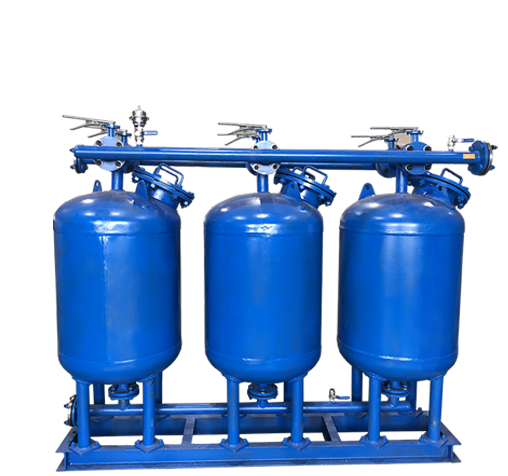In the realm of water treatment, achieving high-quality filtration is essential for various industrial, agricultural, and municipal applications. Shallow sand filters have emerged as a reliable and efficient solution for removing suspended solids and contaminants from water. This article provides an in-depth exploration of shallow sand filters, including product introduction, working principles, technical specifications, and diverse application areas.
Shallow sand filters, also known as rapid sand filters or media filters, utilize a bed of sand or other granular media to remove impurities from water. These filters are designed to handle large volumes of water with high filtration efficiency. They are widely used in water treatment plants, irrigation systems, and industrial processes due to their robustness and ease of operation.

Key Features of Shallow Sand Filters:
High Filtration Efficiency: Capable of removing suspended solids, turbidity, and particulate matter from water.
Versatility: Suitable for various applications, including potable water treatment, wastewater treatment, and industrial water filtration.
Ease of Operation: Simple design and operation with minimal maintenance requirements.
Cost-Effective: Economical solution for large-scale water filtration needs.
Scalability: Available in various sizes and configurations to meet specific water treatment requirements.
The working principle of shallow sand filters is based on the physical and biological processes that occur within the filter media. Water passes through a bed of sand or other granular material, where impurities are trapped and removed. The filtration process involves several mechanisms:
Mechanical Straining: Larger particles are physically trapped in the spaces between the sand grains.
Sedimentation: Suspended particles settle onto the sand grains due to gravity.
Adsorption: Dissolved contaminants adhere to the surface of the sand grains.
Biological Activity: Microorganisms present in the filter media break down organic matter and other contaminants.
Components of a Shallow Sand Filter:
Filter Media: The primary filtration material, typically consisting of sand, anthracite, or other granular media.
Filter Bed: The layer of filter media through which water passes.
Underdrain System: A network of pipes or channels located at the bottom of the filter bed that collects filtered water and distributes it evenly during backwashing.
Inlet and Outlet Structures: Structures that control the flow of water into and out of the filter.
Backwash System: A mechanism for cleaning the filter media by reversing the flow of water to remove trapped particles and contaminants.

The performance and design of shallow sand filters are determined by several technical parameters. These specifications vary depending on the specific application and system requirements. Key technical parameters include:
Filter Media Type: Commonly used media include silica sand, anthracite, and garnet. The choice of media depends on the desired filtration efficiency and specific contaminants to be removed.
Effective Size (ES): The size of the filter media particles, typically measured in millimeters (mm). The effective size affects the filtration rate and efficiency.
Uniformity Coefficient (UC): A measure of the uniformity of the filter media particle sizes. A lower UC indicates more uniform particles, leading to more consistent filtration performance.
Filtration Rate: The rate at which water passes through the filter media, usually measured in gallons per minute per square foot (gpm/ft²) or liters per second per square meter (L/s/m²). Typical filtration rates range from 2 to 12 gpm/ft².
Bed Depth: The depth of the filter media bed, typically ranging from 24 to 48 inches (60 to 120 cm). Deeper beds provide higher filtration efficiency and longer run times between backwashes.
Backwash Rate: The rate at which water is pumped through the filter media during backwashing, usually measured in gallons per minute per square foot (gpm/ft²) or liters per second per square meter (L/s/m²). Typical backwash rates range from 15 to 20 gpm/ft².
Operating Pressure: The pressure at which the filter operates, typically ranging from 10 to 30 psi (0.7 to 2.1 bar).
Flow Capacity: The volume of water the filter can process, usually measured in gallons per day (GPD) or cubic meters per hour (m³/h). Flow capacities vary based on the filter size and design.
Applications of Sand Media Filters
Sand media filters find extensive applications in various water treatment scenarios. One prominent application is in storm water runoff management. For instance, in urban areas prone to heavy rainfall, these filters can effectively remove debris, sediment, and contaminants from the runoff before it enters water bodies. This helps prevent soil erosion and reduces the pollution load in rivers and lakes.
In the industrial sector, sand media filters play a crucial role in purifying industrial process water. Consider a manufacturing plant that uses large amounts of water for cooling or cleaning purposes. The filters can remove impurities and suspended solids, ensuring the water quality meets the strict standards required for the industrial processes. This not only enhances the efficiency of the operations but also reduces the risk of equipment damage and product contamination.
Incoming plant water is another area where sand media filters shine. Before the water is used in various processes within a facility, the filters ensure it is free from harmful substances and particulates. This is particularly important in industries where the quality of the input water can significantly impact the final product or the performance of the machinery.
Waste water clean-up is yet another significant application. In wastewater treatment plants, sand media filters are often used as part of a multi-stage treatment process to remove residual contaminants and fine particles, making the water suitable for discharge or reuse.
Pre-filtration for other processes, such as granular activated carbon, reverse osmosis, cartridge or bag filtration, and deionized water, is also a common use. By removing larger particles and impurities upfront, the sand media filters protect the downstream filtration systems, prolong their lifespan, and improve the overall efficiency of the water treatment process.
Overall, the versatility and effectiveness of sand media filters make them indispensable in a wide range of water treatment applications, ensuring clean and safe water for various purposes.












